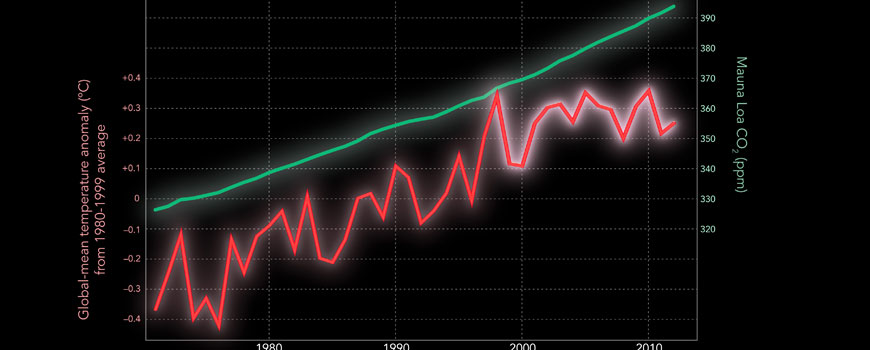Please note: The Academy will close at 3 pm today for Big Bang Gala.
Science News
A Break From Warming
September 3, 2013
by Molly Michelson

While the planet warmed steadily at a rate of 0.13° C per decade since 1950, since 1998 it’s been on a hiatus, despite the fact that levels of carbon dioxide, the main greenhouse gas produced by human activities, continued a steady rise, reaching 400 parts per million for the first time in human history in May 2013.
Two researchers from Scripps Institution of Oceanography at UC San Diego discovered the reason for this hiatus, publishing their findings last week in Nature.
The reason for the warming break? Cooling in the eastern tropical Pacific Ocean. The team predicts that long-term global warming will resume when the tropical Pacific switches back to a warm state.
The researchers arrived at their conclusion using innovative computer modeling methods to simulate regional patterns of climate anomalies. This enabled them to see global warming in greater spatial detail, revealing where it has been most intense and where there has been no warming or even cooling.
The current cooling phase began just after a strong El Niño year in 1998. The study considers the tropical Pacific Decadal Oscillation (PDO), a climate cycle that plays out over the course of several decades. Within this large pattern fall El Niño and La Niña, well-known faster cycles that cause shifts in the distribution of warm water in the equatorial Pacific Ocean. While El Niño and La Niña last only a few years, the PDO lasts several decades. The last time it was in a cooling phase—cooling waters in the eastern equatorial Pacific Ocean—it lasted from roughly 1940 to the early 1970s. The researchers are unsure how this long this phase will last.
“That speaks to the challenge in predicting climate for the next few years,” says study co-author Shang-Ping Xie. “We don’t know precisely when we’re going to come out of [the hiatus] but we know that over the timescale of several decades, climate will continue to warm as we pump more greenhouse gases into the atmosphere.”
“These compelling new results provide a powerful illustration of how the remote eastern tropical Pacific guides the behavior of the global ocean-atmosphere system, in this case exhibiting a discernible influence on the recent hiatus in global warming,” says Dan Barrie, program manager at the NOAA Climate Program Office.
Image: Kosaka, Xie/Scripps